Current Research
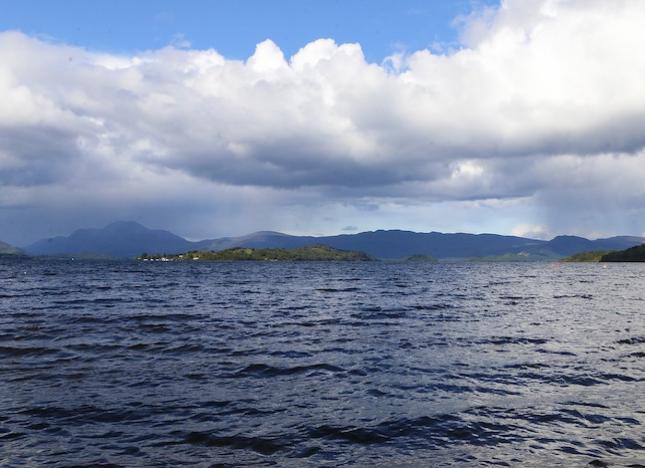 Current research at SCENE reflects the strengths of the University of Glasgow's Institute of Biodiversity, Animal Health & Comparative Medicine,with its focus on evolutionary biology, eco-physiology (animal health), disease ecology, and environmental change. These areas of fundamental research are complemented by applied, environmentally-oriented projects, of both international significance and local, Scottish impact. This research is supported by a wide range of funding organizations, including the UK research councils, European Union, and various other funders from the UK and abroad.
Current research at SCENE reflects the strengths of the University of Glasgow's Institute of Biodiversity, Animal Health & Comparative Medicine,with its focus on evolutionary biology, eco-physiology (animal health), disease ecology, and environmental change. These areas of fundamental research are complemented by applied, environmentally-oriented projects, of both international significance and local, Scottish impact. This research is supported by a wide range of funding organizations, including the UK research councils, European Union, and various other funders from the UK and abroad.
Taking advantage of the biodiversity on site, research at SCENE involves various organisms (vertebrates, invertebrates, plants), as well as environmental processes like carbon flux. These activities take place in the wide range of ecosystems that surround SCENE. For example, fish and aquatic invertebrates are studied on Loch Lomond, research on woodland birds makes use of 500 nest boxes that are situated in the surrounding oak woodland, studies of disease ecology take place on various islands in Loch Lomond, and lake dynamics are investigated by a monitoring buoy. The studies are complemented by experimental work using SCENE’s laboratory assets, including artificial streams, aquaria and experimental plant-growing plots.
Evolutionary Biology
Brassicaceae variation
Institute academics CURRENT RESEARCH LIST and James Buckley are using Arabidopsis lyrata (a member of the Brassicaceae plant family) to study the effects of variation in plant mating systems (i.e. inbreeding vs outcrossing) and ploidy level (i.e. diploid vs tetraploid) on survival and reproduction in changing environments. This includes changes in both the abiotic (e.g. temperature) and the biotic (e.g. changes in pathogen pressures) environments. To test the response of these plants to novel environmental conditions here in Scotland, A. lyrata plants collected from a wide range of geographic locations across North America and Europe are being grown in an experimental plot at SCENE. Samples collected from this common garden experiment will also be used to understand the physiological responses of these plants (i.e. variation in their ‘metabolome’) to novel environments. The researchers are also interested in the evolution of disease resistance across the geographic range of A.lyrata and specifically resistance to important pathogens of the Brassicaceae family (which includes crops such as cabbage, broccoli and rapeseed).
Freshwater Systems
Glasgow faculty Colin Adams, Felicity Huntingford, Kathryn Elmer and Kevin Parsons and their groups are studying the evolutionary processes that have led to high levels of diversity within species in recently glaciated freshwater systems. Colin Adams’ work also involves a suite of international collaborations, for example with Rune Knudsen (Norway). Several species of fish, notably whitefish, Arctic charr and lamprey, show a remarkable diversity of phenotypes within the species. In many places they exhibit multiple morphs that differ in morphology, behaviour and ecology but live in the same lake.
Genome Analysis
The evolutionary process and its genetic and developmental underpinnings that have promoted this rapid diversification are poorly understood but are fundamental to our understanding of how new species arise. Felicity Huntingford and Colin Adams are particularly interested in the mechanisms at the intersection between behaviour and physiology that drive evolutionary change in several aquatic species. Kathryn Elmer’s group investigates the genetic basis of adaptive phenotypes in wild populations. They use genome-wide analyses combined with insights from ecology to uncover the evolutionary origins of the breadth of biodiversity we see in nature. Elmer’s study systems of focus are salmonid fishes, reptiles and amphibians, because these groups hold great promise for understanding rapid diversification and local adaptation to environmental change.
Insect Evolution
Luc Bussier and his group from Stirling University study insects (Dance flies, Diptera: Empididae) with an interest in evolutionary consequences of sexual dimorphism. As part of these flies’ diverse mating system, many species transfer nutritious nuptial gifts, for which females may compete. In some species females have evolved extravagant ornaments associated with competition for gift-providing males.
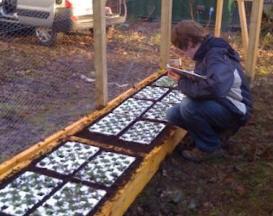
Planting @SCENE
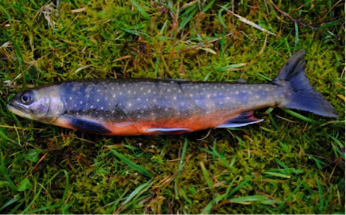
Arctic Charr
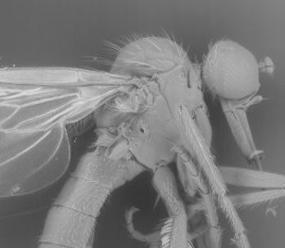
Dancy Fly (Diptera: Empididae)
Eco-physiology (animal health)
Brown Salmon Trout Ecology
Institute researcher Neil Metcalfe has been awarded a prestigious 5 year European Research Council Advanced Grant of £1.8M, to study ‘The Ecology of Metabolic Phenotypes’. The project will examine both why individual animals vary in their metabolic rate, and what the consequences are for their survival and reproductive success. The experimental work will focus on two species of freshwater fish (the brown trout Salmo trutta and the three-spined stickleback Gasterosteus aculeatus, and will in part take place at SCENE, using custom-made experimental facilities including mesocosm ponds with temperature regulation. Further studies of ecophysiology and health of fish take place under the umbrella of IBIS. Travis van Leeuwen is investigating migration strategies of Brown trout (Salmo trutta) in relation to genetic background, metabolic traits and food availability.
Blue Tit Studies
Eco-physiological studies are also carried out on birds. In studies of Blue tits (Cyanistes caeruleus) Shona Smith and Glasgow academic Ruedi Nager investigate whether oxidative stress functions as a link between environmental quality and fitness. Also with an interest in stress, Paul Jerem, Susanne van Donk and Ruedi Nager apply thermal imaging to test whether changes in body temperature can be used to assess avian responses to environmental stressors. This research is in collaboration with Dominic McCafferty, who is interested in the way in which animals are adapted to their thermal environment. His research uses the latest thermal imaging technology to measure the metabolic and temperature responses of individuals to climate.
How do woodland birds tell the time?
Staff member Barbara Helm investigates the biological clocks that tick in virtually all living organisms and aid them in keeping track of time. Together with other avian researchers at SCENE, she studies birds at SCENE to better understand how these clocks influence life in the wild, and how they contribute to fitness and reproduction. At SCENE the group keeps track of phenology of woodland birds and use telemetry to monitor daily cycles. Paul Jerem has just completed a project on activity and body temperature cycles of free-living Great tits (Parus major) during winter.
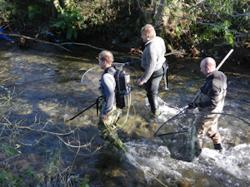
Travis et al

Fieldwork at SCENE can be challenging...
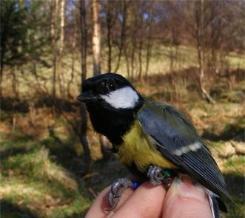
Great Tit fitted with a transmitter
Disease Ecology
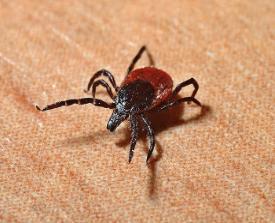 Roman Biek, faculty of the institute, and his group are studying the ecology of Lyme disease in Scotland. Their research aims to understand how changes to species communities alters the chances of people being exposed to this tick-borne pathogen. For this research, the group takes advantage of the many islands in Loch Lomond, where they collect ticks and monitor infection. Most of the islands support populations of small mammals dominated by wood mice (Apodemus sylvaticus) and bank voles (Myodes glareolus). For both species, the island populations are isolated from each other providing useful replicated model species supporting research on population dynamics and parasite and virus transmission.
Roman Biek, faculty of the institute, and his group are studying the ecology of Lyme disease in Scotland. Their research aims to understand how changes to species communities alters the chances of people being exposed to this tick-borne pathogen. For this research, the group takes advantage of the many islands in Loch Lomond, where they collect ticks and monitor infection. Most of the islands support populations of small mammals dominated by wood mice (Apodemus sylvaticus) and bank voles (Myodes glareolus). For both species, the island populations are isolated from each other providing useful replicated model species supporting research on population dynamics and parasite and virus transmission.
Ecology and Environmental Change
Monitoring environmental impacts on woodland birds
Ross MacLeod, fellow of the Royal Society of Edinburgh, studies the ways individuals respond to environmental pressures and changing environments. He is particularly interested in trade-offs between the opposing pressures of predators on the one hand, and food supply on the other. In his studies of woodland birds (Blue tits, great Tits, Coal tits and chaffinches), he uses automated weighing platforms in the oak woodlands around SCENE to track weight changes in common birds with the goal of using ecological theory to better understand how natural habitats are responding to environmental change. The results are being used to develop new, more rapid and more cost effective approaches to environmental monitoring that will be able to act as early warning systems of future environmental problems.
Collecting environmental data in Loch Lomond
Glasgow faculty Susan Waldron’s and Leena Vihermaa’s research is part of the NERC-funded United Kingdom Lake Ecological Observatory Network (UKLEON). Using a monitoring buoy with state-of-the-art sensor technology, they collect high frequency meteorology and water chemistry time series for Loch Lomond. Establishment of the technology aims at overcoming the limitations to detailed time series of environmental data that were due to sampling frequency. Their research addresses both seasonal and short term controls of carbon dynamics in lake systems and will yield key information for climate modelling.
Sea Monitor
SeaMonitor is a unique marine research project studying the seas around Ireland, Western Scotland and Northern Ireland. The project is led by the Loughs Agency and supported by another eight leading marine research institutions using innovative marine species tracking technology to better understand and protect vulnerable marine life in our oceans.
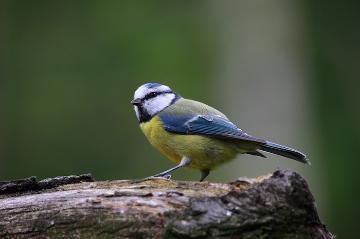
Blue tit
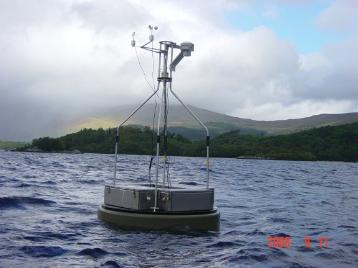
Environmental monitoring
Current Research at SCENE
Click on the Project Title for more information about the project.

